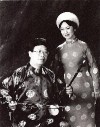Welcome to Cải Lương Việt Nam English Edition, the only website about Vietnamese traditional music such as : cai luong, tan co giao duyen, hat boi, hat cheo….Đây là trang web của cailuongvietnam.com English Edition .Đây cũng là nơi dừng chân của những người yêu BẢN SẮC DÂN TỘC, những người thiết tha...

In recent years, the music industry’s dynamics have shifted towards fandom and celebrityhood, giving performers more ownership over their music and forming a direct channel for them to communicate their artistry to fans. A song today is, more often than not, closely linked with its performing artist rather than its writer, because in many cases, they are the same person.
For much of Vietnam’s modern music timeline, however, the reverse was more common. Across the 1980s and 1990s, songs, first and foremost, were the creations of composers; and each song could have myriad versions performed by different singers, all vying for the earshot of listeners. My parents identify their favorite tracks by who wrote it, and would argue fervently over which vocalists had the best rendition. Composers were so revered for their artistry and personal style that at times their music could grow to become distinctive genres that are even alive and well today, such as nhạc Trịnh Công Sơn or nhạc Phạm Duy. It’s rather comical to think of a Ryan Tedder, Teddy Park, or Hứa Kim Tuyền anthology CD released today.

Như Quỳnh in the 1990s in her 20s. Photo via Nhạc Xưa.
One thing that my parents, and likely many listeners from their generation, would agree on, however, is nobody can sing ‘Người Tình Mùa Đông’ quite like Như Quỳnh. In an era of music when singers were often seen as mere technical executors rather than creators, the enduring impression that this particular version has etched onto our collective consciousness is a testament to Như Quỳnh’s star power, right from the song's very first debut performance.
The title ‘Người Tình Mùa Đông’ could be loosely translated as ‘Winter Paramour.’ The song appeared for the first time in 1994 in the Christmas special of a variety music show by diaspora entertainment studio Asia. The rest of this festive set list naturally featured many Vietnamese versions of famous Noël songs, including ‘Last Christmas’ by Wham! and the Spanish-language classic ‘Feliz Navidad.’
The title ‘Người Tình Mùa Đông’ seems a little hyperbolic at first glance, because the Vietnamese winter is typically much less melodramatic than that of the western world. Apart from some northern provinces where the weather does get chilly towards the end of the year (but no snow), our tropical climate renders winter in the rest of Vietnam rather impotent, hardly romantic enough to inspire seasonal love songs. In reality, the lyrics that composer Anh Bằng wrote use winter as a metaphor for the chilly demeanor with which the love interest treats the male narrator in his reminiscence. “Đường vào tim em ôi băng giá / How icy is the road to your heart,” the man laments as the rainy weather takes him back to those days with her. “Trái tim em muôn đời lạnh lùng. Hỡi ôi trái tim mùa đông / Your heart is forever chilly. O wintry heart,” the song ends on a rather bittersweet note.
This story of male yearning and missed connection is only apparent if one pays attention to the lyrics, because the performance is anything but forlorn. Như Quỳnh walks out on an ivory stage embellished with Christmas trees and white balloons, and starts singing. The music is bouncy and festive, and the melancholy lyrics take on a rather playful and tongue-in-cheek quality, when delivered by Như Quỳnh, as she smiles and sways in place. The song becomes a self-aware assertion from the female perspective, thanks to the Vietnamese language’s flexible pronouns — it’s as if she’s coyly affirming “Yes, it’s not easy to win my affection, what about it?”

The 1980s outfit that has become iconic. Photo via Nhạc Xưa.
This was Như Quỳnh’s first stage performance since she moved abroad; she was 23 years old in the tape recording. Even though she had performed publicly before in Saigon and even won singing competitions, many still single out this performance as the defining moment in Quỳnh’s career. I attribute this to the song’s broad appeal, to viewers both male and female, young and old. Its lyrics are underscored by nostalgia, a key quality that resonates with Vietnamese communities abroad and older fans. Male listeners are obviously drawn to the ingénue image she put on for the live recording; perhaps she reminded them of a similar crush during their formative years. Female viewers, on the other hand, could connect with the confidence and self-assertion in the performance.
She’s fun, dresses well, and is literally glowing. The makeup and fashion are flattering, and the singing is naturalistic and not overly indulgent in vocal acrobatics. In the performance, Như Quỳnh wears a red peacoat, a beige pleated miniskirt, black tights and a black beret — a look that has become so iconic that she even recreated it for her comeback concert in Hanoi in 2018. While this ensemble evoked heavy 1980s influence and might look a little dated if seen during the 2010s, it appears surprisingly in place today, given the resurgence of appreciation for retro aesthetics in the 2020s across multiple cultural disciplines from music, cinema to fashion.
That memorable live stage might have been the first time many Vietnamese heard ‘Người Tình Mùa Đông,’ but few are aware that this melody actually originated from Japan under the name ルージュ (Rouge/Lipstick), written by singer-songwriter Miyuki Nakajima for veteran singer Naomi Chiaki. ‘Rouge’ was released as a single in 1977 for Chiaki’s album, but it underperformed compared to the rest of the tracks. If ‘Người Tình Mùa Đông’ sings of regret and unfulfilled relationships of a man, ‘Rouge’ is the reminiscence of a woman who left home in search of a long-lost lover and had to find temporary work as a bar hostess. Her lover is nowhere to be found, and she reflects on how the journey has changed her, yet her sakura-color lipstick remains the same.
Reader Comments
Older articles
 Le Thuy – 50-Year Career in Performing
Le Thuy – 50-Year Career in Performing
 The magic of the Vong Co song
The magic of the Vong Co song
 Legendary cai luong singer Thanh Duoc passes away in US
Legendary cai luong singer Thanh Duoc passes away in US
 THE SURVIVAL OF THE TRADITIONAL MUSIC (NHAC CO TRUYEN)
THE SURVIVAL OF THE TRADITIONAL MUSIC (NHAC CO TRUYEN)
 Dustin Nguyen jump starts his career and a new life
Dustin Nguyen jump starts his career and a new life
 Overseas trips of Ca tru singer
Overseas trips of Ca tru singer
 Queen of cai luong brought back to life on stage
Queen of cai luong brought back to life on stage
 Actress Bich Hanh’s biography and memories
Actress Bich Hanh’s biography and memories
 Kien Giang’s contestant claims top prize at Vong Co singing contest
Kien Giang’s contestant claims top prize at Vong Co singing contest
 In Memory of Singer Nhật Sơn
In Memory of Singer Nhật Sơn
 Vietnamese director triumphs at San Francisco Film Festival
Vietnamese director triumphs at San Francisco Film Festival
 The Multiverse Behind the 1990s Classic 'Người Tình Mùa Đông' by Như Quỳnh
The Multiverse Behind the 1990s Classic 'Người Tình Mùa Đông' by Như Quỳnh
 French drama blended with traditional Vietnamese music presented in HCMC
French drama blended with traditional Vietnamese music presented in HCMC
 First Vietnamese actor wins at Golden Bell Awards
First Vietnamese actor wins at Golden Bell Awards
 Sa Dec Flower—Ornamental Festival 2025 to be held in December
Sa Dec Flower—Ornamental Festival 2025 to be held in December
 Vietnam wins Bronze Award at EXPO 2025 Osaka-Kansai
Vietnam wins Bronze Award at EXPO 2025 Osaka-Kansai
 Vietnam Pho Festival 2025 to be held in Singapore in October
Vietnam Pho Festival 2025 to be held in Singapore in October
 NS Hong Nga: Going to the US to live a difficult life, being neglected by her children, returning to Vietnam to be sick and lonely
NS Hong Nga: Going to the US to live a difficult life, being neglected by her children, returning to Vietnam to be sick and lonely
 Today is Vulan, the Day of Mother Worship and Welcoming Ghosts
Today is Vulan, the Day of Mother Worship and Welcoming Ghosts
 Phuong Le was said to be infatuated, so she posted only 4 words, trying to hold on to Vu Luan?
Phuong Le was said to be infatuated, so she posted only 4 words, trying to hold on to Vu Luan?